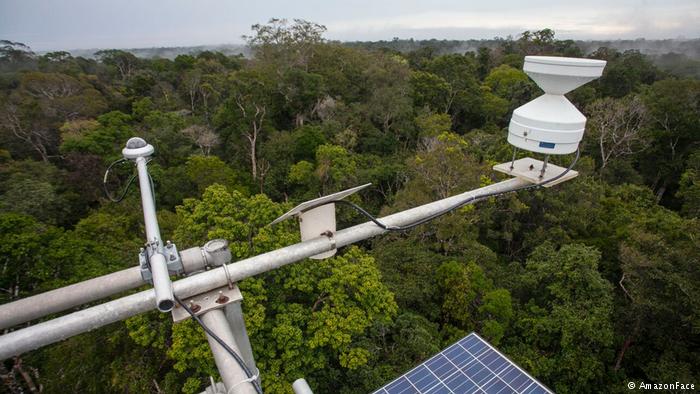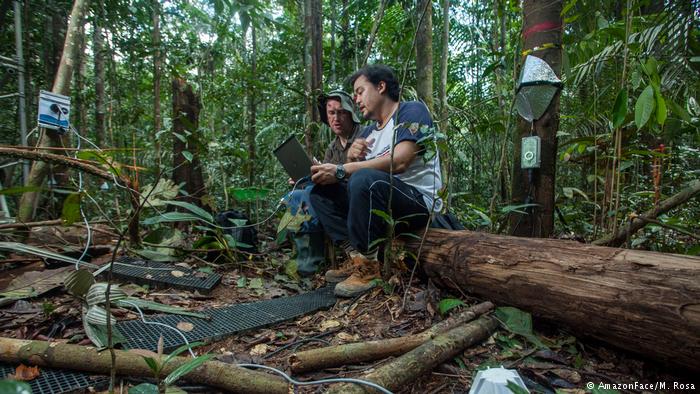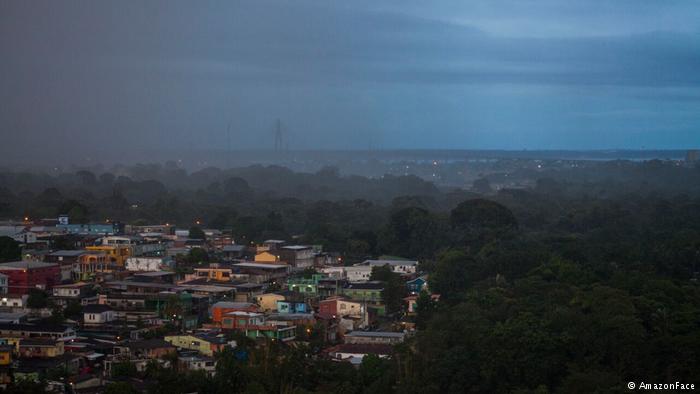Levels of carbon dioxide in the Earth’s atmosphere are rising rapidly as we burn fossil fuels. We know the danger that poses in terms of climate change. But scientists are less sure about the direct effect of more CO2 on tropical forests like the Amazon.
One intriguing theory is that more CO2 might actually make forests more resilient to the impacts of climate change.
A quick recap on photosynthesis: Plants use solar energy to convert carbon dioxide and water into sugar molecules, as well as oxygen, which is released back into the atmosphere.
So, if they receive an extra dose of carbon dioxide will that make them more productive?
David Lapola of the State University of Campinas in Brazil says there is “great uncertainty” about what will happen to the Amazon, and it’s time that changed. Studying the impact of carbon dioxide on growth could add an important piece to the puzzle.
“We can’t just rely on theories without evidence any longer,” he told DW.
Scientists on the AmazonFACE project hope their data will increase our understanding of the forest’s ecosystems
Testing the impact of future CO2 levels
At a research station near Manaus, the capital of Brazil’s Amazonas state, Lapola’s international team of scientists will use Free-Air CO2 Enrichment – or FACE – technology to increase carbon dioxide in areas of forest with a 30-meter diameter, by 50 percent – bringing it to the level expected around 2050.
The experiment will last 10 years, over which time they will observe how ecosystems react in comparison with control areas.
In a best-case scenario, the rise in carbon dioxide would stimulate forest growth, making it more resilient to warmer weather and drought, and going some way to counterbalance the impacts of climate change.
At the same time, if plants use up the extra carbon dioxide, there will be less of it in the atmosphere to cause climate change. The extra growth could increase the Amazon’s utility as a carbon sink.

The solar-powered monitoring system captures data on radiation, humidity, precipitation and CO2 at the canopy
Will nutrients put the breaks on growth?
This will be the first study into the “CO2-fertilization effect” on a tropical forest. But similar research has been carried out in the United States on pine forests.
“Initially, they saw a good increase in forest productivity,” Lapola says. “That means the forest absorbed the extra carbon and gained biomass.”
But CO2 alone isn’t enough. Extra growth also requires an extra intake of nutrients, and after seven years, the soil’s nitrogen levels began to run low and growth fell back to normal levels.
Lapola says there’s no shortage of nitrogen in the Amazon, but limited phosphorus could have the same result.
“If we observe this limitation, this will be terrible news for the Amazon,” he said.
Too small an effect?
Adalberto Veríssimo, co-founder of Brazilian research institute Imazon, welcomed the “AmazonFace” project as contributing to greater understanding of the complexity Amazonian ecosystems.

Data on forest exposed to heightened CO2 levels will be compared to control areas to predict future impacts of emissions
“If the forest has a role of capturing excess carbon when it is increased in the atmosphere, it’s important that we understand it,” he told DW.
However, the ecologist doubted this effect would be significant enough to have any real impact on global carbon emissions or, therefore, climate change.
“The forest fulfills many roles,” Veríssimo said. “I can’t imagine that it will also fulfill the role of mitigating the insane carbon emissions that humanity is throwing in the atmosphere.”
He was also skeptical that CO2-fertilzation would have a marked impact on resilience compared to the amount of rainfall and risk of extreme weather events.
Preparing for an uncertain future
Still, Lapola believes his research can contribute to environmental policy. “The program can reduce a lot of the uncertainties about what will happen in the Amazon, so we can plan adaptation policies and start preparing people for the future,” he said.

The researchers want to inform better policy to protect both the Amazon’s biodiversity and 30 million people that call it home
The project is currently winding up its initial phase, which monitored the forest before CO2 enrichment and evaluated socioeconomic impact of its degradation on communities in the region.
The results of the FACE experiment should then help scientists and policymakers understand more about what the future holds for the incredible number of plants and animals that live in the Amazon – including 30 million human beings.











